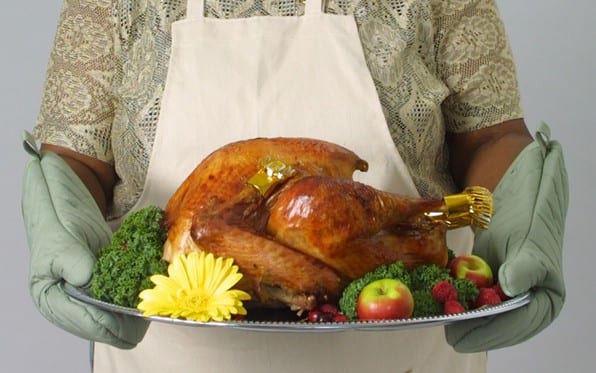By Gig Conaughton, County of San Diego Communications Office
On your marks, get set—start thawing!
That’s right, Thanksgiving, the Super Bowl for home cooking, is next week. And if you’re cooking a turkey and the Thanksgiving feast for your family or your friends, you need to start thinking about safe cooking right now, including thawing the bird!
If you don’t, your feast, from the salad to the turkey to the pie, could become tainted with bacteria like salmonella, listeria and E. coli that could make you, your guests and your family sick.
For example, the safest way to thaw a turkey, or any meats for that matter, is in your refrigerator. But you need to leave yourself time—at least 24 hours for every five pounds of turkey. That means a 20-pound bird would take four days in the fridge to safely thaw.
Fortunately for you, the County’s Department of Environmental Health has a short quiz to help you make sure your Thanksgiving dinner is safe and delicious.
We’ll start with an easy question, just to see if you’ve been paying attention.
What’s the best way to thaw your turkey?
A.Pour hot water on it until it gets soft.
B.Let it sit in a pot of water … until it gets soft.
C.Leave it out on the counter. When it’s soft, it’s ready!
D.A large turkey should be defrosted in the refrigerator for at least 24 hours for every five pounds it weighs.
Answer: D of course. (We just went over this.) The best and safest way to defrost a turkey is in the refrigerator. That’s because temperatures below 40 degrees Fahrenheit will slow most bacteria’s ability to multiply. Note: The USDA says that you can also thaw turkeys in cold water. But — and this is important — the water must be cold, under 40 degrees, and should be changed every 30 minutes to keep it cold. The refrigerator’s easier! Here’s more information about thawing turkeys.
How can you tell when your turkey is done — and cooked safely?
A.When it smells good!
B.When your meat thermometer says the turkey’s internal temperature has reached at least 165 degrees Fahrenheit.
C.Mom told you it would take 20 minutes per pound.
D.It will turn brown.
Answer: If you picked “B” you’re correct!
You should always use a meat thermometer to determine if meat is safely cooked to temperatures that will kill bacteria. Turkey and poultry should be cooked to internal temperatures of 165 degrees Fahrenheit, checking in the innermost part of the thigh, innermost part of the wing and the thickest part of the breast. You should also use your meat thermometer to make sure leftovers are re-heated to 165 degrees. Here’s more about safe cooking temperatures.
Why should you keep raw meats and meat products separated from fruits and vegetables when cutting them up and preparing them?
A.Vegetables will make your meat taste weird.
B.Raw meat, meat products and blood can carry bacteria that can contaminate fruits and vegetables — and make you sick.
C.Putting meats and vegetables together will confuse your vegetarian guests.
D.Meats and vegetables don’t get along.
Answer: If you said “B” you’re right!
According to the USDA, “cross-contamination” — the transfer of harmful bacteria from one food, especially raw meats, poultry and shellfish, to other foods — is one of the most common causes of food-borne illness. You need to keep raw meats and their juices away from already-cooked foods and ready-to-eat foods such as nuts, fruits and vegetables. If you can, use separate cutting boards for meats and produce. If you can’t, wash cutting boards with hot, soapy water after using them on raw meats and before you use them to cut fruits and vegetables!
How often should you wash your hands and cutting boards when preparing food?
A.Before you start preparing food.
B.If you sneeze or if have to run to the bathroom.
C.After you pet the dog, or cat, or the gerbil—or pick up the kids.
D.All of the above, but mainly, “OFTEN!”
Answer. “D” You should wash your hands and cutting boards before and after all of those items above. Hand-washing is a vital part of safe cooking. Harmful bacteria such as E. coli, salmonella and staphylococcus aureus, as well as viruses, can be removed from people’s hands by properly washing your hands. Here are a few other things you should wash up after doing: after sneezing or coughing or blowing your nose, playing with the kids, handling money, eating, drinking or smoking, after handling or preparing raw food.
Should you rinse off fruits and vegetables?
A.They grew in nature; they’re good with me.
B.Not if they look clean.
C.The supermarket washes them, right?
D.You should rinse fruits and vegetables with cold water to remove lingering dirt that can carry bacteria.
Answer: Absolutely D. Yes, rinsing with cold water cleans off dirt and other contaminants. But don’t wash them with detergents or soap, even dishwashing soap. You could end up eating residues from those cleaners if they’re absorbed by fruits and vegetables.
What is the Danger Zone? And what does it have to do with Thanksgiving dinner?
A.It’s the distance you have to carry all the Thanksgiving food from your kitchen to the table — without dropping everything and ruining the feast.
B.It’s that song from the 80s movie “Top Gun.” You know, “R-i-i-i-de into the danger zooooone!” Has nothing to do with Thanksgiving.
C.It’s the range of temperatures between 40 degrees Fahrenheit and 140 degrees Fahrenheit — the temperatures where bacteria can grow like crazy in foods, doubling in number in as little as 20 minutes.
Answer: As much as we love Top Gun, the correct answer is C!
The Danger Zone is that range of temperatures between 40 and 140 degrees Fahrenheit in which bacteria love to breed. If hot food cools, or cold food heats up, enough to enter that zone, your food can become a bacteria-fest and you can end up getting sick. To avoid that, keep hot foods safely heated with chafing dishes, preheated steam tables, warming trays, slow cookers and ovens. Place cold foods in containers on ice, or in the fridge. And refrigerate leftovers as soon as you can. Here’s more about the “Danger Zone.”
Is the “five-second rule” real? Can you eat something you’ve dropped on the floor if you pick it up in less than five seconds?
A.Yes, it’s real and of course you can! Nothing can contaminate your food in less than five seconds.
B.It’s not real. You really shouldn’t eat anything you’ve dropped on floor.
C.I’ve eaten stuff that’s been on the floor a lot longer than five seconds and nothing happened to me.
Answer: B. C’mon! It’s OK for the dog to eat food that’s fallen to the ground, but it’s not safe for you. Truth is, almost any contact is long enough for food to be contaminated by bacteria that can be found on the ground or in your house. According to research conducted this year by Rutgers University, bacteria can transfer from a surface to food in less than a second!
So there you have it. We hope you’re an expert. But if you’re still interested, you can get more information about food safety tips at the USDA’s Food Safety and Inspection website, or call the Meat and Poultry hotline at 1-888-674-6854.

















